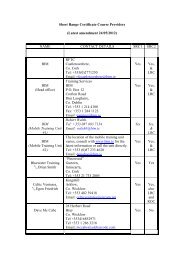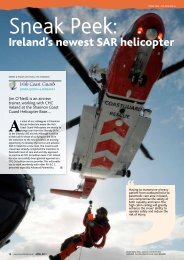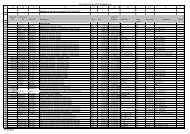Syllabus - Certificate of Competency as Second Engineer Officer.pdf
Syllabus - Certificate of Competency as Second Engineer Officer.pdf
Syllabus - Certificate of Competency as Second Engineer Officer.pdf
You also want an ePaper? Increase the reach of your titles
YUMPU automatically turns print PDFs into web optimized ePapers that Google loves.
SYLLABUS 2<br />
CERTIFICATE OF COMPETENCY AS SECOND ENGINEER OFFICER<br />
(EXAMINATION SYLLABUS)<br />
THERMODYNAMICS<br />
Pressure, Temperature, Energy:<br />
Explain the effects <strong>of</strong> pressure and temperature on solids, liquids and g<strong>as</strong>es; define and me<strong>as</strong>ure<br />
temperature; discuss heat <strong>as</strong> a form <strong>of</strong> energy; discuss specific heat capacity, sensible heat, latent<br />
heat and solve <strong>as</strong>sociated problems; discuss the physical changes <strong>of</strong> solids, liquids and g<strong>as</strong>es<br />
<strong>as</strong>sociated with changes in temperature.<br />
Heat Transfer:<br />
Explain how heat may be transferred in different media and outline the factors which influence heat<br />
transfer; solve simple problems involving conduction, convection and radiation.<br />
Internal Energy, Thermodynamic Systems, First Law:<br />
Define and describe thermo-dynamic systems and solve problems involving the First Law <strong>of</strong><br />
Thermodynamics.<br />
G<strong>as</strong> Laws, Displacement, Work:<br />
Solve simple problems involving the b<strong>as</strong>ic g<strong>as</strong> laws; describe processes which will produce a change<br />
<strong>of</strong> state in a non-flow system and solve problems concerned with non-flow processes.<br />
Ideal Cycles, Internal Combustion Engines:<br />
Sketch P/V diagrams and describe the operation <strong>of</strong> the ideal constant volume (Otto) cycle, the Diesel<br />
cycle and the Dual Combustion cycle; determine indicated power, brake power and mechanical<br />
efficiency <strong>of</strong> an internal combustion engine and solve problems involving power, efficiency, fuel<br />
consumption and heat balance.<br />
Air Compressors:<br />
Describe the factors which influence the performance <strong>of</strong> a reciprocating air compressor and solve<br />
simple problems involving single stage, single acting, compressors.<br />
Working Fluids:<br />
Recognise the differences in the properties <strong>of</strong> vapours, g<strong>as</strong>es and the perfect g<strong>as</strong> and use the steam<br />
tables to solve simple problems related to water and steam in the wet, saturated and superheated<br />
states.<br />
Nozzles, Steam Turbines:<br />
Solve simple problems involving the flow <strong>of</strong> steam through a nozzle.<br />
Refrigeration:<br />
Explain the principle <strong>of</strong> the reversed heat engine cycle and its application to vapour compression<br />
refrigeration plant and solve simple problems; heat pump; coefficient <strong>of</strong> performance.<br />
Issue Date: 31/10/08<br />
Revision No: 001<br />
49
Combustion:<br />
Discuss the combustion <strong>of</strong> solid and liquid fuels in terms <strong>of</strong> m<strong>as</strong>s, theoretical air and excess air<br />
requirements and explain the products <strong>of</strong> combustion. Solve problems involving the combustion <strong>of</strong> a<br />
fuel.<br />
Boiler Feed Densities:<br />
Discuss the effects <strong>of</strong> using feed water <strong>of</strong> different densities in boiler and evaporating plant; consider<br />
the effects <strong>of</strong> dissolved solids in feed water; solve simple problems on the change in density <strong>of</strong> boiler<br />
and evaporator plant due to build up <strong>of</strong> dissolved solids; consider the effects <strong>of</strong> intermittent and<br />
continuous blowdown.<br />
APPLIED MECHANICS<br />
Statics<br />
Solve problems involving forces in static equilibrium; discuss pin jointed frameworks and solve<br />
related problems; solve problems involving centres <strong>of</strong> gravity and centroids.<br />
Friction<br />
Discuss friction; coefficient <strong>of</strong> friction; solve problems relating to friction between relatively moving<br />
rigid bodies on horizontal and inclined planes; consider linear and circular motion.<br />
Kinematics<br />
Solve problems involving linear, angular and relative motion; describe the motion <strong>of</strong> projectiles and<br />
solve <strong>as</strong>sociated problems; explain and solve problems relating to relative velocity.<br />
Dynamics<br />
Discuss the concepts <strong>of</strong> force and energy and solve <strong>as</strong>sociated problems; Law <strong>of</strong> conservation <strong>of</strong><br />
energy; conservation <strong>of</strong> momentum; discuss centripetal and centrifugal effects and solve <strong>as</strong>sociated<br />
problems.<br />
Machines<br />
Law <strong>of</strong> machines; discuss the principles <strong>of</strong> simple machines and solve <strong>as</strong>sociated problems.<br />
Strength <strong>of</strong> Materials<br />
Discuss the effects on materials caused by the application <strong>of</strong> external force and solve <strong>as</strong>sociated<br />
problems; discuss the effects on materials by changes in temperature; discuss and solve problems<br />
involving stress in thin rotating rims; discuss stresses involved in cantilevers, simply supported<br />
beams, rotating shafts and solve related problems.<br />
Hydrostatics<br />
Discuss Principle <strong>of</strong> Archimedes and solve <strong>as</strong>sociated problems; discuss and solve problems relating<br />
to hydrostatic forces on immersed are<strong>as</strong>; consider liquids <strong>of</strong> different density.<br />
Hydrodynamics<br />
Discuss and solve problems relating to liquids in motion; nozzles; orifice plates.<br />
Issue Date: 31/10/08<br />
Revision No: 001<br />
50
MATHEMATICS<br />
Arithmetic<br />
Express quantities in the form <strong>of</strong> a ratio, proportion or percentage.<br />
Algebra<br />
Use the rules <strong>of</strong> Algebra and solve <strong>as</strong>sociated problems.<br />
Logarithms<br />
Understand and use logarithms to undertake mathematical calculations.<br />
Graphs<br />
Discuss and demonstrate graphic representation <strong>of</strong> numerical quantities.<br />
Trigonometry<br />
Discuss and solve problems involving the b<strong>as</strong>ic laws <strong>of</strong> trigonometry.<br />
Mensuration<br />
Solve problems related to plane figures and solids.<br />
Calculus (Differentiation)<br />
Discuss differential calculus and solve <strong>as</strong>sociated problems.<br />
Calculus (Integration)<br />
Discuss integral calculus and solve <strong>as</strong>sociated problems.<br />
ENGINEERING DRAWING<br />
General Note:<br />
It is expected that students will be aware <strong>of</strong> and comply with the requirements <strong>of</strong> a recognised<br />
standard such <strong>as</strong> British Standards BS 308.<br />
<strong>Engineer</strong>ing Communication<br />
Discuss the need for <strong>Engineer</strong>ing Drawing <strong>as</strong> a means <strong>of</strong> communication.<br />
Drawing Equipment<br />
Discuss the use and care <strong>of</strong> drawing instruments.<br />
Projection<br />
Discuss the use <strong>of</strong> orthographic and isometric projection in <strong>Engineer</strong>ing Drawing.<br />
Assembly Drawings<br />
Produce general <strong>as</strong>sembly drawings, including sectioned drawings, from dimensioned isometric<br />
views <strong>of</strong> various components commonly used in marine engineering.<br />
Issue Date: 31/10/08<br />
Revision No: 001<br />
51
MARINE ELECTROTECHNOLOGY<br />
Electric and Electronic Components<br />
Understand and discuss the physical construction, characteristics and practical application <strong>of</strong> b<strong>as</strong>ic<br />
electrical and electronic components.<br />
Electric Circuit Principles<br />
Understand and discuss linear DC and AC electrical circuits and solve related problems; circuit<br />
protection; distribution; switchgear design; instrumentation.<br />
Electromagnetism<br />
Understand and discuss the principles <strong>of</strong> magnetism; electromagnetic induction; practical<br />
applications.<br />
Electrical Machines<br />
Understand and discuss the principles <strong>of</strong> operation <strong>of</strong> DC and AC machines; commutation; control;<br />
thermal and environmental protection and cl<strong>as</strong>sification; practical applications including propulsion.<br />
Approvals/certification.<br />
Understand and discuss the cl<strong>as</strong>sification <strong>of</strong> electrical equipment and cabling; relevance and<br />
recognition <strong>of</strong> international standards and symbols.<br />
NAVAL ARCHITECTURE AND SHIP CONSTRUCTION<br />
Hydrostatics<br />
Understand and discuss the principles <strong>of</strong> flotation; describe the use <strong>of</strong> TPC in calculating<br />
displacement and the effect <strong>of</strong> addition or removal <strong>of</strong> m<strong>as</strong>ses on draught; calculate changes in mean<br />
draught due to changes in density; describe the various co-efficients <strong>of</strong> form and their relevance;<br />
describe wetted surface area and calculate its value.<br />
Simpson's Rule<br />
Apply Simpson's Rule to the determination <strong>of</strong> are<strong>as</strong>, volumes and m<strong>as</strong>ses; first moments <strong>of</strong> area,<br />
volume and m<strong>as</strong>s.<br />
Ship Stability<br />
Calculate the position <strong>of</strong> the centre <strong>of</strong> gravity <strong>of</strong> a ship under any condition <strong>of</strong> loading; understand<br />
the meaning <strong>of</strong> stability and the importance <strong>of</strong> centre <strong>of</strong> buoyancy, centre <strong>of</strong> gravity and metacentre<br />
with regard to transverse stability; solve problems on changes in mean draught due to bilging; effects<br />
<strong>of</strong> permeability; understanding <strong>of</strong> free-surface effect.<br />
Ship Resistance<br />
Understand and discuss the b<strong>as</strong>ic factors involved in the resistance to a ship's motion caused by the<br />
water; use <strong>of</strong> test-tanks and models.<br />
Propellers<br />
Explain and discuss the principles <strong>of</strong> screw propellers; propeller terminology; cavitation; slip.<br />
Issue Date: 31/10/08<br />
Revision No: 001<br />
52
Admiralty coefficients<br />
Discuss Admiralty Coefficient and its use <strong>as</strong> an approximate method <strong>of</strong> estimating power<br />
requirements.<br />
Fuel Consumption<br />
Calculate the variation in fuel consumption with speed; determine fuel requirements for particular<br />
voyages for ships with different characteristics.<br />
Ship stresses, shearing forces and bending moments<br />
Discuss the different stresses to which a ship's structure is subject; explain and discuss the relevance<br />
<strong>of</strong> shearing forces and bending moments on ship structures; explain the effects resulting from<br />
different loading conditions, ball<strong>as</strong>ting, sea-states, etc; solve b<strong>as</strong>ic problems relating to same.<br />
Ship Terminology<br />
Demonstrate knowledge <strong>of</strong> terms commonly used in ship design and construction.<br />
Ship Construction<br />
Discuss and explain the different framing systems used in construction <strong>of</strong> ships; recognise and<br />
discuss the design features <strong>of</strong> the different ship types (Tanker, Bulk-carrier, OBO, Combination, Ro-<br />
Ro, LNG, LPG, General Cargo, Chemical, Heavy-Lift, Tug, Offshore Supply, etc); understand the<br />
function and constructional details <strong>of</strong> different components <strong>of</strong> the ships structure; understand and<br />
distinguish between the design and constructional details <strong>of</strong> different types <strong>of</strong> rudders and how they<br />
are integrated into the ship's structure; discuss internal and integral tank structures; design and<br />
construction <strong>of</strong> hatchways and hatch-covers; anchor equipment design, operation and integration into<br />
the ship's structure; attachment <strong>of</strong> deck machinery and fittings, bulwarks, bollards, fairleads, winches,<br />
derricks, cranes, etc.<br />
Ship drawings<br />
Familiarity with the layout and use <strong>of</strong> typical ship's drawings, shell expansion, midship section,<br />
bulkhead plans, scantling drawings, tank plans, drydocking plans, manhole cover plans, etc.<br />
Materials <strong>of</strong> construction<br />
Understand and discuss the different materials used in the construction <strong>of</strong> ships and their equipment;<br />
grading and cl<strong>as</strong>sification <strong>of</strong> materials; use <strong>of</strong> high-tensile materials; effects <strong>of</strong> low temperatures.<br />
Protection <strong>of</strong> ship structures<br />
Understand and discuss use <strong>of</strong> cathodic and impressed current protection system; different paint<br />
systems; principles <strong>of</strong> anti-fouling systems; environmental considerations.<br />
Ventilation<br />
Discuss ventilation requirements on different vessel types; explain typical ventilation arrangements;<br />
monitoring and control; risks/dangers with ventilation systems; safety features.<br />
Filling/drainage <strong>of</strong> tanks or compartments<br />
Understand and discuss the arrangements for preventing overpressure or underpressure in tanks;<br />
stripping; drainage arrangements for superstructure spaces; local and remote sounding arrangements.<br />
Watertight integrity<br />
Watertight doors and controls; cross-flooding and down-flooding arrangements.<br />
Issue Date: 31/10/08<br />
Revision No: 001<br />
53
Structural Fire Protection<br />
Understand the statutory requirements in relation to structural fire protection <strong>of</strong> different vessel types;<br />
cl<strong>as</strong>sification <strong>of</strong> fire zones, bulkheads and decks; construction <strong>of</strong> fire resisting bulkheads and decks;<br />
standard fire test; approval <strong>of</strong> materials; openings and penetrations in bulkheads and decks; protection<br />
<strong>of</strong> stairways and escape routes.<br />
Statutory Certification and Cl<strong>as</strong>sification<br />
Understand the relevance <strong>of</strong> Loadline, Safety Construction and P<strong>as</strong>senger <strong>Certificate</strong>s in the<br />
construction <strong>of</strong> a vessel; discuss "conditions <strong>of</strong> Assignment"; understand the role <strong>of</strong> the<br />
Administration and the function <strong>of</strong> Recognised Organisations to whom authority might be delegated;<br />
obligation to report deficiencies; understand the constructional features <strong>of</strong> life-saving appliances;<br />
discuss the constructional features <strong>of</strong> ships relating to environmental protection requirements;<br />
understand the statutory certification relating to safety equipment and pollution prevention.<br />
ENGINEERING KNOWLEDGE<br />
General Notes:<br />
The General Knowledge section <strong>of</strong> the examination for the issue <strong>of</strong> a certificate <strong>of</strong> competency <strong>as</strong><br />
<strong>Second</strong> engineer <strong>of</strong>ficer will be divided into written and oral sections.<br />
<strong>Certificate</strong>s <strong>of</strong> <strong>Competency</strong> <strong>as</strong> <strong>Second</strong> <strong>Engineer</strong> <strong>Officer</strong> may be issued in Steam, Motor or combined<br />
Steam and Motor. Candidates for the steam examination will not be required to demonstrate<br />
familiarity with main diesel propulsion engines but will be expected to be familiar with auxiliary<br />
diesel engine plant and systems. Similarly, candidates for the motor examination will not be required<br />
to demonstrate familiarity with main steam propulsion systems but will be expected to be familiar<br />
with auxiliary steam plant and systems.<br />
The engineering knowledge to be shown by candidates is that which is required to ensure the use,<br />
operation and maintenance <strong>of</strong> the machinery, equipment and ship structures, usually in the charge <strong>of</strong><br />
the <strong>Second</strong> <strong>Engineer</strong> <strong>Officer</strong>, in a safe, efficient and environmentally friendly manner. A thorough<br />
knowledge <strong>of</strong> the legal and managerial responsibilities <strong>of</strong> a <strong>Second</strong> <strong>Engineer</strong> <strong>Officer</strong> will be required.<br />
Candidates must also demonstrate a sufficient appreciation <strong>of</strong> the duties <strong>of</strong> the Chief <strong>Engineer</strong><br />
<strong>Officer</strong>.<br />
Candidates may be required to illustrate their written answers by means <strong>of</strong> sketches.<br />
Oral examination:<br />
The oral examination will include questions on the operation and management <strong>of</strong> boilers, main and<br />
auxiliary machinery; support systems and equipment; electrical machinery and systems; control<br />
systems; environmental concerns; safety related installations, equipment and procedures; actions in<br />
event <strong>of</strong> different emergency/breakdown situations; general maintenance procedures; specific<br />
overhaul/repair procedures; routine ship practice.<br />
Candidates will be required to demonstrate a good working knowledge <strong>of</strong> Irish and International<br />
maritime legislation relating to safety at sea, security and pollution prevention. In addition, they must<br />
be familiar with relevant legislation relating to keeping safe engineering watches at sea and in port,<br />
the obligations to personnel working on board, the relevant codes <strong>of</strong> safe working practice, carriage<br />
<strong>of</strong> dangerous goods, STCW Convention, ISM and ISPS Code implications.<br />
Issue Date: 31/10/08<br />
Revision No: 001<br />
54
Candidates should be well acquainted with significant marine accidents or c<strong>as</strong>ualties especially those<br />
related to machinery space operations or general ship operations in which the <strong>Second</strong> <strong>Engineer</strong><br />
<strong>Officer</strong>, or personnel from whom he is responsible, may play a significant role. Candidates must be<br />
aware <strong>of</strong> how such accidents might be prevented.<br />
GENERAL ENGINEERING KNOWLEDGE:<br />
Properties and characteristics <strong>of</strong> metals, materials, liquids, g<strong>as</strong>es and vapours used in marine<br />
engineering.<br />
Processes to which the component parts <strong>of</strong> machinery are submitted or which are incidental to their<br />
manufacture and use.<br />
Installation and alignment <strong>of</strong> machinery; connection to prime movers; belt, gear, fluid and flexible<br />
drive systems.<br />
Design and construction details, principles <strong>of</strong> operation, manner <strong>of</strong> attachment to ship or<br />
incorporation into ship structures or systems <strong>of</strong> different items <strong>of</strong> marine machinery or equipment.<br />
General marine instrumentation, sensing and monitoring devices used in typical marine engineering<br />
applications.<br />
Different types <strong>of</strong> pumps and <strong>as</strong>sociated systems.<br />
Storage, transfer, treatment, purification, filtration, and general handling <strong>of</strong> fuel and lubricating oils.<br />
Piping systems in general; materials and construction; valve types; expansion arrangements.<br />
Distribution systems including, steam, bilge, ball<strong>as</strong>t, fire, cooling media, fuel, lubricating and<br />
hydraulic oils, air and g<strong>as</strong>es;<br />
Arrangements <strong>of</strong> ship side or skin fittings, injection chests, prevention <strong>of</strong> fouling in piping systems.<br />
Fluid heating systems; steam and thermal oil systems; arrangements within tanks.<br />
Propulsion transmission systems; gearing; thrust blocks; clutches; shafting and bearings.<br />
Sterngear arrangements; sterntubes; fixed and variable pitch propellers, azimuthing propellers, vane<br />
propellers, methods <strong>of</strong> improving propeller efficiency and recovering wake energy.<br />
Principles <strong>of</strong> lubrication; properties <strong>of</strong> lubricants; synthetic lubricants; additives; biological<br />
contamination; purification, clarification and treatment <strong>of</strong> lubricants.<br />
Steering machinery; stabilising systems; thrusters.<br />
Refrigeration machinery, air conditioning and ventilation systems.<br />
Fresh water production, storage and conditioning systems.<br />
Issue Date: 31/10/08<br />
Revision No: 001<br />
55
G<strong>as</strong> turbines in marine applications<br />
Deck machinery and cargo handling systems.<br />
Sanitary and sewage systems.<br />
Boiler water level gauges, boiler mountings, safety valves and any test or operational procedures<br />
<strong>as</strong>sociated with these items.<br />
Auxiliary steam systems; boilers; steam distribution and utilisation; general feed water systems;<br />
boiler water treatment.<br />
Auxiliary steam equipment, turbo-alternators, turbo-pumps, different condensing systems.<br />
Air compressors, air receivers, air filtration and drying systems.<br />
Constructional details <strong>of</strong> alternators, generators, motors, switchgear, batteries. Earthing <strong>of</strong> low and<br />
high voltage alternators.<br />
Electrical distribution systems, switchboards, transformers, cabling, fuses, circuit breakers, protective<br />
devices and trips. Earthing <strong>of</strong> high and low voltage systems. Safety with HV systems. Steering gear<br />
electric circuits.<br />
Emergency generators, batteries, switchboards and consumers; direct and supplementary emergency<br />
lighting.<br />
Electrical propulsion systems.<br />
Inert g<strong>as</strong> systems; generation and distribution; safety devices and operation.<br />
Construction and operation <strong>of</strong> power operated watertight doors and their control systems.<br />
Construction, operation and maintenance <strong>of</strong> life-saving appliances; different types <strong>of</strong> lifeboats;<br />
liferafts; marine escape systems; various launching appliances.<br />
Design and construction <strong>of</strong> fixed and portable fire extinguishing appliances and systems; fixed g<strong>as</strong><br />
smothering installations; water spray, sprinkler and drencher systems; emergency fire pump and<br />
firemain arrangements.<br />
Structural fire protection; cl<strong>as</strong>sification <strong>of</strong> insulation ratings; designation <strong>of</strong> fire zones; standard fire<br />
test; constructional details <strong>of</strong> insulated bulkheads and decks; fire rated penetrations in structures for<br />
the p<strong>as</strong>sage <strong>of</strong> cables, pipes, ducting; fire-doors and shutters. Requirements for escape routes,<br />
photoluminescent strip lighting and signs.<br />
Fire detection systems; different detectors; addressable systems.<br />
Inspection <strong>of</strong> the vessel in drydock.<br />
Arrangements for prevention <strong>of</strong> pollution <strong>of</strong> the marine environment; oily-water separator;<br />
incinerators; garbage management; sludge disposal; treatment <strong>of</strong> cargo residue; atmospheric<br />
emissions, sewage pollution, antifouling.<br />
Issue Date: 31/10/08<br />
Revision No: 001<br />
56
Operational safety matters.<br />
Operation, testing and fault rectification <strong>of</strong> automatic control systems, alarm panels and<br />
instrumentation.<br />
Safe and efficient operation in the U.M.S. mode.<br />
Procedures to be adopted for operating main machinery under emergency conditions.<br />
Safe and efficient operation <strong>of</strong> electrical generation plant; paralleling and disconnecting alternators<br />
and generators; switchboards. Testing electrical distribution systems, switchboards, transformers,<br />
cabling, fuses, circuit breakers, protective devices and trips. Earthing <strong>of</strong> high and low voltage<br />
systems. Safety with HV systems. Steering gear electric circuits.<br />
Operational practice and fault finding <strong>as</strong>sociated with AC and DC electrical systems. Testing <strong>of</strong><br />
electrical motors and equipment,<br />
Management <strong>of</strong> pumping operations to minimise stability implications.<br />
Safe working practice, familiarity with relevant codes, overhauling machinery, safety in workshop<br />
practice, use <strong>of</strong> welding and burning equipment, personal protective equipment, lifting and rigging<br />
equipment, entering and testing tanks or enclosed spaces.<br />
Precautions against fire or explosion, explosive mixtures, danger <strong>of</strong> oil leakages or spillages, sources<br />
<strong>of</strong> ignition, safety devices, me<strong>as</strong>uring instruments.<br />
Awareness <strong>of</strong> toxic and other dangerous materials typically in use in marine engineering practice;<br />
cleaning and treatment chemicals; carriage <strong>of</strong> dangerous goods.<br />
Practical fire prevention, detection and extinction throughout the ship; testing and operation <strong>of</strong> fixed<br />
and portable fire extinguishing appliances and systems; use <strong>of</strong> firemens outfits, including breathing<br />
apparatus; testing <strong>of</strong> fire detection and alarm systems; planning effective fire drills; prevention <strong>of</strong><br />
spread <strong>of</strong> fire, boundary cooling.<br />
Management, control and organisation <strong>of</strong> response in emergency situations; fire and damage control;<br />
ventilation management; emergency evacuation; treatment <strong>of</strong> injured personnel.<br />
Preparation <strong>of</strong> the vessel for entering drydock; procedures before, during and after drydocking.<br />
Actions required in the event <strong>of</strong> grounding or collision.<br />
Me<strong>as</strong>ure to prevent pollution <strong>of</strong> the marine environment; good housekeeping; compilation <strong>of</strong> oilrecord<br />
book; action in event <strong>of</strong> pollution incident; use <strong>of</strong> Shipboard Oil Pollution Emergency Plan<br />
(SOPEP), garbage management, sewage pollution prevention, air pollution prevention.<br />
Design and construction <strong>of</strong> exhaust systems; heat recovery arrangements; emission controls and<br />
arrangements; catalytic converters.<br />
Knowledge and familiarity with the use <strong>of</strong> IT for marine engineering applications.<br />
Issue Date: 31/10/08<br />
Revision No: 001<br />
57
Knowledge <strong>of</strong> International Conventions and certification required by vessels, including ISM and<br />
ISPS<br />
MAIN STEAM PROPULSION SYSTEMS.<br />
Main steam boilers; construction; superheaters; g<strong>as</strong> and steam air heaters; sootblowing; refractory<br />
materials; control and alarm systems; mountings and safety devices.<br />
Combustion theory and practice; air/fuel ratio; forced and induced fan systems; different atomization<br />
systems.<br />
Fuel systems related to different types <strong>of</strong> fuel.<br />
Main feed water systems; feed pumps; condensers; vacuum generation; extraction; de-aeration;<br />
chemical testing and treatment; contamination/leak detection.<br />
Main propulsion steam turbines; design and construction; drainage; expansion arrangements; safety<br />
devices; vibration monitoring.<br />
Main reduction gearing systems; design and construction; lubrication arrangements; safety devices<br />
and monitoring arrangements.<br />
Main steam plant construction and operation; efficiency; <strong>as</strong>tern running; emergency procedures;<br />
raising steam from cold condition.<br />
MAIN MOTOR/DIESEL PROPULSION SYSTEMS.<br />
Main Diesel engines (trunk and crosshead types), design and construction <strong>of</strong> individual components,<br />
materials used.<br />
Starting and reversing systems; timing requirements and arrangements.<br />
Fuel oil, lubricating oil and cooling systems; conditioning and treatment systems.<br />
Turbocharging, supercharging, intercooling and scavenging systems.<br />
Me<strong>as</strong>urement <strong>of</strong> power, indicator and peak pressure diagrams, adjustments.<br />
Control and alarm systems <strong>as</strong>sociated with automatic operation <strong>of</strong> a diesel plant.<br />
Safe and efficient operation <strong>of</strong> marine diesel engines.<br />
Safety devices and protection systems.<br />
Causes <strong>of</strong> and appropriate action in the event <strong>of</strong> scavenge fire, crankc<strong>as</strong>e explosion, overspeeding,<br />
etc.<br />
Routine and emergency maintenance procedures; inspection <strong>of</strong> components; essential spare parts.<br />
Issue Date: 31/10/08<br />
Revision No: 001<br />
58


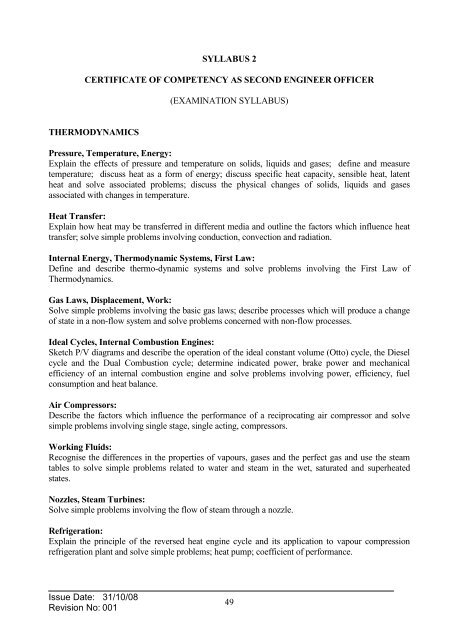
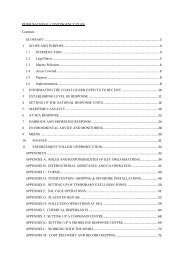
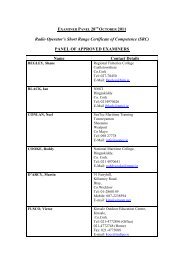

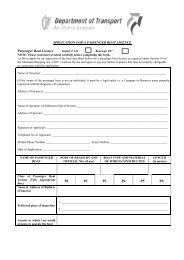
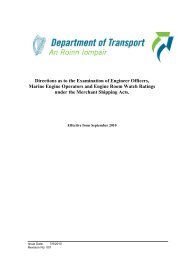
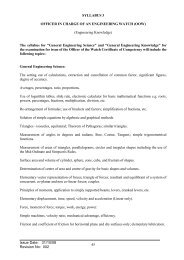
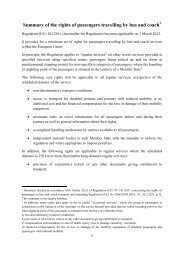


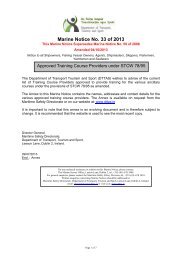
![memorandum of understanding [mou] - Department of Transport](https://img.yumpu.com/36967920/1/184x260/memorandum-of-understanding-mou-department-of-transport.jpg?quality=85)
